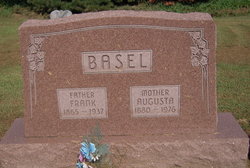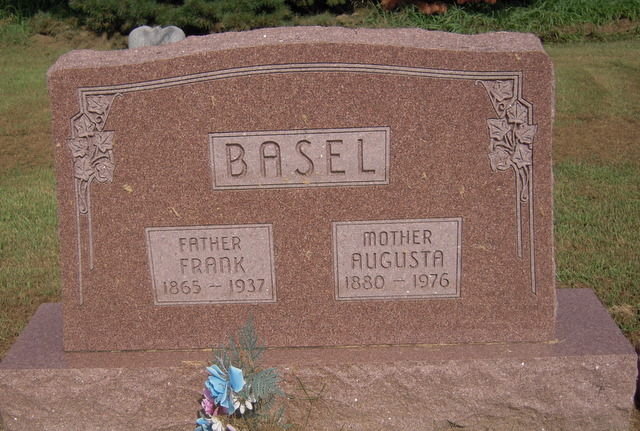In 1883, at the age of 18, he sailed for America, and arrived at Wahoo, Nebraska, on December 21, 1883. After hiring out as a farm hand for several years, he saved enough money to pay his parents' transportation from Germany to Wahoo, and they remained with him until their deaths.
In 1886, he began farming east of Wahoo. Three years later he and his parents moved to the John Miller place southeast of Ithaca, Nebraska.
On February 18, 1901, he married Augusta Wendt. It was the first wedding in the then newly erected Zion Lutheran Church.
In 1910, he bought the Wilson farm, 5 miles east of Ceresco, Nebraska, where he resided until his death.
To the happy union were born 10 children, two of which died in infancy. Otto, Herbert, Marie, Elsie, Alfred, Frank, Orville all live in the near vicinity while Gustav resides in Lincoln, Nebraska.
Mr. Basel died from a cancerous tumor with which he had been afflicted since the Christmas of 1935, and which made him bedfast since the middle of last January. After relapsing into a coma, which lasted approximately 4 days, he passed to his heavenly reward at his home Sunday evening, May 23. The funeral services were conducted at the Zion Lutheran church on May 26, and the body was buried at the Lutheran cemetery. Rev. S. Herforth conducted the services.
The deceased became a member of Zion Lutheran Church in 1891, and was on the church board for many years, acting as church treasurer nine years and as church secretary an additional nine years. He always took an active interest in the welfare of his church as well as the good of the community, ever eager to help where he could. It is with great sorrow and deep respect that we pay our tribute to an American pioneer and to a true Christian who has left the world a better place in which to live. May he rest in peace.
Besides his eight children to mourn his death, there are his wife, Augusta, his brothers, Herman of Wahoo, NE, Reinhardt of Brunswick, NE, Robert of Wahoo, and his sisters, Mrs. Carl Zimmerman of Wahoo and Mrs. Charles Conrad of David City, NE.
~~~~~~~~~~~~~~~~~~~~~~~~~~~~~~~~~~~~~~~
obituary; Note: Pomerania (Polish: Pomorzeⓘ ; German: Pommernⓘ ; Kashubian: Pòmòrskô; Swedish: Pommern) is a historical region on the southern shore of the Baltic Sea in Central Europe, split between Poland and Germany. The central and eastern part belongs to the West Pomeranian, Pomeranian and Kuyavian-Pomeranian voivodeships of Poland, while the western part belongs to the German states of Mecklenburg-Western Pomerania and Brandenburg.
Pomerania's historical border in the west is the Mecklenburg-Western Pomeranian border Urstromtal, which now constitutes the border between the Mecklenburgian and Pomeranian part of Mecklenburg-Western Pomerania, while it is bounded by the Vistula River in the east. The easternmost part of Pomerania is alternatively known as Pomerelia, consisting of four sub-regions: Kashubia inhabited by ethnic Kashubians, Kociewie, Tuchola Forest and Chełmno Land.
Pomerania has a relatively low population density, with its largest cities being Gdańsk and Szczecin. Outside its urban areas, it is characterized by farmland, dotted with numerous lakes, forests, and small towns. In the west of Pomerania lie several islands, the largest of which are Rügen, the largest island in Germany; Usedom/Uznam, and Wolin, the largest island in Poland. The region has a rich and complicated political and demographic history at the intersection of several cultures.
Geography
17th-century map of the Duchy of Pomerania
Borders
Pomerania is the area along the Bay of Pomerania of the Baltic Sea between the rivers Recknitz, Trebel, Tollense and Augraben in the west and Vistula in the east.[1][2] It formerly reached perhaps as far south as the Noteć river, but since the 13th century its southern boundary has been placed further north--Wikipedia; kind assistance of FindaGrave volunteer The Busbooms 48605773
~~~~~~~~~~~~~~~~~~~~~~~~~~~~~~~~~~~~~~~
In 1883, at the age of 18, he sailed for America, and arrived at Wahoo, Nebraska, on December 21, 1883. After hiring out as a farm hand for several years, he saved enough money to pay his parents' transportation from Germany to Wahoo, and they remained with him until their deaths.
In 1886, he began farming east of Wahoo. Three years later he and his parents moved to the John Miller place southeast of Ithaca, Nebraska.
On February 18, 1901, he married Augusta Wendt. It was the first wedding in the then newly erected Zion Lutheran Church.
In 1910, he bought the Wilson farm, 5 miles east of Ceresco, Nebraska, where he resided until his death.
To the happy union were born 10 children, two of which died in infancy. Otto, Herbert, Marie, Elsie, Alfred, Frank, Orville all live in the near vicinity while Gustav resides in Lincoln, Nebraska.
Mr. Basel died from a cancerous tumor with which he had been afflicted since the Christmas of 1935, and which made him bedfast since the middle of last January. After relapsing into a coma, which lasted approximately 4 days, he passed to his heavenly reward at his home Sunday evening, May 23. The funeral services were conducted at the Zion Lutheran church on May 26, and the body was buried at the Lutheran cemetery. Rev. S. Herforth conducted the services.
The deceased became a member of Zion Lutheran Church in 1891, and was on the church board for many years, acting as church treasurer nine years and as church secretary an additional nine years. He always took an active interest in the welfare of his church as well as the good of the community, ever eager to help where he could. It is with great sorrow and deep respect that we pay our tribute to an American pioneer and to a true Christian who has left the world a better place in which to live. May he rest in peace.
Besides his eight children to mourn his death, there are his wife, Augusta, his brothers, Herman of Wahoo, NE, Reinhardt of Brunswick, NE, Robert of Wahoo, and his sisters, Mrs. Carl Zimmerman of Wahoo and Mrs. Charles Conrad of David City, NE.
~~~~~~~~~~~~~~~~~~~~~~~~~~~~~~~~~~~~~~~
obituary; Note: Pomerania (Polish: Pomorzeⓘ ; German: Pommernⓘ ; Kashubian: Pòmòrskô; Swedish: Pommern) is a historical region on the southern shore of the Baltic Sea in Central Europe, split between Poland and Germany. The central and eastern part belongs to the West Pomeranian, Pomeranian and Kuyavian-Pomeranian voivodeships of Poland, while the western part belongs to the German states of Mecklenburg-Western Pomerania and Brandenburg.
Pomerania's historical border in the west is the Mecklenburg-Western Pomeranian border Urstromtal, which now constitutes the border between the Mecklenburgian and Pomeranian part of Mecklenburg-Western Pomerania, while it is bounded by the Vistula River in the east. The easternmost part of Pomerania is alternatively known as Pomerelia, consisting of four sub-regions: Kashubia inhabited by ethnic Kashubians, Kociewie, Tuchola Forest and Chełmno Land.
Pomerania has a relatively low population density, with its largest cities being Gdańsk and Szczecin. Outside its urban areas, it is characterized by farmland, dotted with numerous lakes, forests, and small towns. In the west of Pomerania lie several islands, the largest of which are Rügen, the largest island in Germany; Usedom/Uznam, and Wolin, the largest island in Poland. The region has a rich and complicated political and demographic history at the intersection of several cultures.
Geography
17th-century map of the Duchy of Pomerania
Borders
Pomerania is the area along the Bay of Pomerania of the Baltic Sea between the rivers Recknitz, Trebel, Tollense and Augraben in the west and Vistula in the east.[1][2] It formerly reached perhaps as far south as the Noteć river, but since the 13th century its southern boundary has been placed further north--Wikipedia; kind assistance of FindaGrave volunteer The Busbooms 48605773
~~~~~~~~~~~~~~~~~~~~~~~~~~~~~~~~~~~~~~~
Inscription
FATHER
Family Members
Sponsored by Ancestry
Advertisement
Explore more
Sponsored by Ancestry
Advertisement














